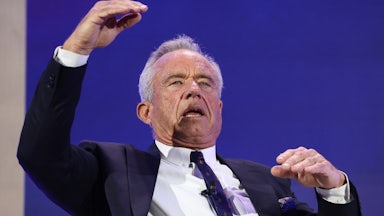While President Donald Trump is scrambling to try to fix all of the economic problems he’s caused with his own policies, many American families may be heading toward a disaster. And the proximate cause may end up being not what the administration has done, but what it’s not doing.
In October, foreclosure starts were up 20 percent compared to the year before, according to numbers from ATTOM, a real estate analysis firm. Moreover, the rate has been rising for eight months in a row. Because it can take banks as many as three months to start the foreclosure process, these cases aren’t caused by momentary blips from the government shutdown. These are continuing signs that American families have been struggling to pay their bills all year.
None of these numbers have risen to Great Recession levels, but the fact that they are following years of record lows in foreclosures is a bad sign, pointing to a crisis over the horizon. Averting such a calamity isn’t easy in most instances. This administration, however, is not even trying.
Some of the most worrying signs involve, as the saying goes, “location, location, location.” The states with the highest foreclosure rates over the past few months include Florida, Nevada, South Carolina, and Texas. These are states that saw a huge uptick in home prices and sales throughout the pandemic, before the Federal Reserve Board started to raise interest rates to calm runaway inflation.
One of the reasons the first creases of this disruption are starting in these locales is that private home insurance is becoming increasingly unaffordable in some of these states, and families, in turn, are struggling to make their monthly payments. At the same time, home prices are falling relative to where they were during the overheated market in 2020 and 2021, so buyers can’t sell their properties to get out from under ballooning costs. “It’s a good example where you have both a combination of falling home values and insurance costs that are climbing up that seem to be kicking off this foreclosure issue,” said Alex Jacquez, chief of policy and advocacy at the nonprofit Groundworkers Collaborative.
All of which means that people feel stuck in their homes even as monthly payments climb.
There are other factors at work, as well. Joel Berner, chief economist at Realtor, said in a blog post at Realtor.com in August that Nevada and Florida are also states that rely heavily on tourism. “Tourism tends to be volatile, and when economic growth slows as it has this year, that industry is often the first and most painfully impacted. Some homeowners in these states may be losing their jobs and becoming unable to make their mortgage payments,” he said.
Vacations are one of the first things families cut out of their budgets when hard times hit. But the job market is fairly volatile right now, no matter which sector is under the microscope. Economists believe a labor market slowdown is ahead, and some of the economic uncertainty caused by Trump’s policies, including tariffs, is making companies nervous about adding jobs.
Month to month, more families are struggling to make ends meet. Housing costs, whether it’s in the form of rent or a mortgage, are usually the biggest monthly expense families have, and they remain at record highs.
It’s not just the cost of housing that’s squeezing families, however. After the Supreme Court squashed hopes that President Joe Biden would help rein in the student loan debt that’s strangling many millennials, borrowers are now having to pay back into a less forgiving system. Trump ended Biden’s signature income-based repayment program, which capped monthly payments and kept borrowers from accruing too much interest, and is making it harder for some borrowers to receive public service student loan forgiveness for work in nonprofits and the public sector. The administration is talking about selling the entire student loan portfolio, essentially privatizing it. That means many borrowers could go without the protections they’re used to. Meanwhile, almost all borrowers are being saddled with high monthly student loan payments that might have been more manageable a few years ago.
On top of that, utility bills are increasing. A new report from the Century Foundation says many Americans can expect bills that are 7.6 percent higher this winter as compared to last. These costs are rising because of many factors that aren’t quickly solved; unfortunately they’re also a monthly bill that most Americans can’t skip. The impact of these higher costs is already being felt electorally: Two Democrats won spots on the Georgia Public Service Commission earlier this month because of the affordability crisis hitting people’s energy costs.
Additionally, most families will see their health insurance premiums skyrocket in 2026 because the enhanced tax subsidies on the Affordable Care Act marketplaces were allowed to expire. On average, the cost of premiums on the marketplace are going up about 26 percent. But some families who buy their insurance on the marketplaces will see their premium costs go up even more because they will no longer qualify for subsidies they once enjoyed. Beyond that, everyone is likely to see some increase, even if they get their insurance from their employer, because healthier people will opt out of insurance altogether and make those covered more expensive to pay for.
All of this means that many Americans are seeing more and more necessities stretch beyond their budgets, all while they feel insecure in their jobs and the safety net is being whittled away. This could be just the beginning of a new wave of foreclosures that topples Americans’ delicate financial security.
To solve this, Trump has only floated a widely criticized idea that seems to have come on a whim: a 50-year mortgage, which was quickly dismissed by experts. It would barely lower monthly payments for borrowers and instead saddle them with hundreds of thousands of dollars in interest over the life of the loan, while it takes them decades to build equity.
At the same time, Trump’s tariff policy continues to steer the economy toward a disaster while he tries to pressure the independent Fed to lower interest rates, even if that’s not the right policy for the moment. And Trump and the Republican Party continue to refuse to even acknowledge that climate change is already happening, which means homeowners in states with increasingly unaffordable home insurance are on their own.
“People are getting killed on the cost of living,” Jacquez said. “These are real, structural, big-ticket items on people’s balance sheets that they’re struggling to afford.”










